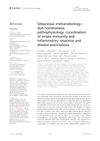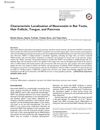TLDR Triphenylphosphine oxide can increase oil production and reduce inflammation in skin cells without affecting TRPM5.
The study explores the effects of the TRPM5 antagonist triphenylphosphine oxide (TPPO) on human sebocytes, finding that TPPO enhances sebaceous lipogenesis and modulates immune responses independently of TRPM5. TPPO increases lipid production and alters cytokine expression, notably increasing IL-6 and decreasing IL-8, through pathways involving Akt, EGFR, and p38α MAPK. These changes suggest potential therapeutic benefits for inflammatory skin conditions like atopic dermatitis or psoriasis, without adverse effects on sebaceous glands. The study confirms that TRPM5 is not functionally active in sebocytes, and TPPO's effects are mediated through multiple signaling pathways, highlighting its potential in acne treatment strategies.
 21 citations
,
November 2022 in “Frontiers in immunology”
21 citations
,
November 2022 in “Frontiers in immunology” Sebaceous glands play a key role in skin health, immunity, and various skin diseases.
12 citations
,
March 2021 in “Journal of Investigative Dermatology” TRPM5 is crucial for maintaining hair growth.
26 citations
,
August 2018 in “Journal of Investigative Dermatology” Activating TRPV3 reduces skin oil production and increases inflammation, potentially causing dry skin issues.
 10 citations
,
January 2016 in “Dermatology”
10 citations
,
January 2016 in “Dermatology” Psoriasis lesions have fewer and smaller oil glands, which might affect the condition's development.
323 citations
,
November 1984 in “Journal of Investigative Dermatology”
12 citations
,
March 2021 in “Journal of Investigative Dermatology” TRPM5 is crucial for maintaining hair growth.
 5 citations
,
January 2018
5 citations
,
January 2018 The conclusion is that a new test was created to find substances that affect specific ion channels, and it works well for drug discovery.
 116 citations
,
September 2020 in “Nature Communications”
116 citations
,
September 2020 in “Nature Communications” The research identified various cell types in mouse and human teeth, which could help in developing dental regenerative treatments.
 2 citations
,
March 2019 in “Journal of Histochemistry and Cytochemistry”
2 citations
,
March 2019 in “Journal of Histochemistry and Cytochemistry” Neuronatin is found in specific cells within rat testis, hair follicles, tongue, and pancreas, suggesting it has various roles in tissue development and function.
 September 2023 in “Research Square (Research Square)”
September 2023 in “Research Square (Research Square)” TNC+ fibroblasts play a key role in skin inflammation by interacting with T cells.









